 Legal Pitching Positions
Legal Pitching Positions
There are two legal pitching positions – the windup position [ 5.07(a)(1) ] and the set position [ 5.07(a)(2) ]. What differentiates the two is the position of the pitcher's feet as he engages the pitching rubber prior to delivering the pitch.
Important: The terms "pivot foot" and "free foot" are important. The pivot foot corresponds to a pitcher's handedness. That is, a right-handed pitcher's pivot foot is his right foot; for lefties, the pivot foot is the left foot.
In this article we're covering three topics:
The Windup Position
Pitchers typically use the windup position when there are no runners on base, or, if there are base runners, when there is little or no threat the runners will steal (e.g., R3 only or bases loaded). This is for two reasons.
First, the windup position imposes limits on the legal actions the pitcher may take which make it difficult to hold runners on their bases. Second, the pitching motion to the plate takes longer than from the set position, which would give a base runner an advantage when stealing. So the windup position is a handicap with runners on base.
The windup position puts specific requirements on the pitcher by rule:
- The pitcher must stand facing the batter and his pivot foot must be touching the pitching rubber. (More about foot positions below.)
- Before delivering the pitch, he will bring both hands together in front of his body. Once brought together, the pitcher may not separate his hands except to do one of three things:
- Deliver the pitch to the batter,
- Step and throw to an occupied base to pick off a batter, or
- Properly disengage the rubber by stepping backward off the rubber with the pivot foot.
- If the pitcher separates his hands other than for these three reasons, it is a balk.
- From the windup position, any natural movement associated with delivering the ball commits the pitcher to pitching the ball in a single, continuous motion. This includes any motion by hand, arm, or legs. Failing to deliver the pitch is a balk (with runners on base).
The feet in the windup position
In the windup position, the pitcher must stand facing home plate with his pivot foot in contact with the rubber while his free foot is on or behind a line extending through the front edge of the pitching rubber. Both feet must be facing home plate.
The images below the show two arrangements of the pitcher's feet in the windup position, both of them perfectly legal. The red dotted line represents the front of the pitching rubber.
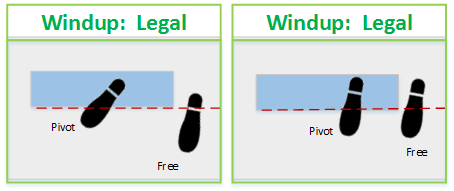
Figure 1. Legal windup position
In both examples, the pivot foot is in contact with the rubber. That's a requirement. The free foot can be beside the rubber, but not in front of it. Some portion of the free foot must be touching or behind the red line marking the front of the pitching rubber.
Following are two more examples of the feet in the windup position. The image on the left depicts the classic setup. The image on the right is also legal, and is perhaps the most common arrangement that you'll see, with both feet in front of the rubber and just touching it.
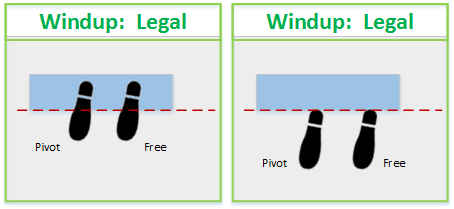
Figure 2. Legal windup position
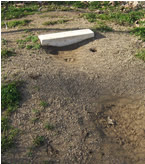
On the frequently imperfect ball fields that amateurs play on, the condition of the pitcher's mound is often quite poor, usually with a deep hole in front of the rubber. The one shown here is worse than most, but you get the idea.
On these fields, the only way a pitcher can adopt the windup position is to set up in the hole in front of the rubber. There should be no daylight between the back of the foot and the front of the rubber, but sometimes there will be a sliver of light. Just let it go. The setup is legal.
Look at the two photos below. Notice the position of the feet. These two photos depict examples of the legal windup positions. The photo on the right show the pitcher taking signs from the catcher; in a moment, he will bring his hands together (as you see on the left) before delivering the pitch.

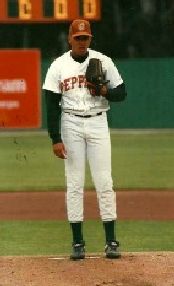
In the photo below, the pitcher is just starting his windup from the windup position.
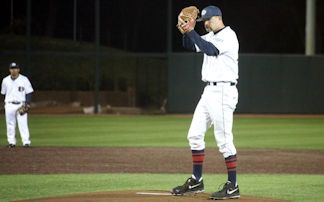
Important: It's important that you glance at the pitcher's feet on every pitch as he engages the rubber and that you make a mental note of the pitching position – windup or set. His pitching position affects what he is allowed to do and what actions may result in a balk or illegal pitch.
Now let's look at arrangements of feet that are not legal for the windup position. Again, it's all about the feet and the red line.
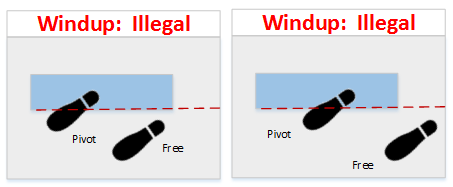
Figure 3. Illegal foot positions from the windup
In both illustrations, the pivot foot is correctly positioned in contact with the rubber. However, in both cases the free foot is entirely in front of the rubber and not in contact with it. In the example on the right, it doesn't matter that the free foot is off to the side of the rubber. What makes the position illegal is that the free foot is beyond the front of the rubber. The feet should also be pointed more toward home plate.
Pitching from the windup position
A pitch from the windup position begins with an initial step with the free foot either to the side or back of the rubber. Either motion is allowed. What's important, though, it that once the motion begins, it must be completed in a single continuous motion. The pitcher cannot hesitate or stop. If he has runners on base, he cannot throw to a base once he's started his pitching motion. He must deliver the pitch, or it is a balk.
Here's a five-second video demonstrating a pitch from the windup position.
The Set Position (and the stretch)
Pitcher's typically switch to the set position when there are runners on base and there is a threat to steal. This is because the set position gives the pitcher more options for containing base runners. That said, increasingly pitchers are using the set position in non-steal situations as well because it provides a simpler, more compact motion. This is particularly true in youth leagues.
The set position is also called the stretch. This is not technically correct, but has nevertheless become common usage. Actually, "the stretch" is a movement that a pitcher makes when pitching from the set position; it's that motion when the pitcher leans in to take signs from the catcher prior to straightening up and coming fully set. We'll see this in a moment.
The feet in the set position
In the set position [ 5.07(a)(2) ], the pivot foot is on or in front of the pitching rubber and fully in contact with it. The free foot is beside the pivot foot on the home-plate side. Rather than facing home plate (as with the windup position), the pitcher is facing the general direction of third base (if right-handed) or first base (if left-handed).

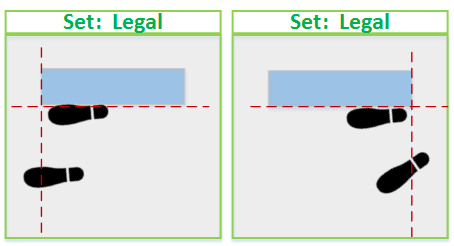
Figure 4. Two views of legal foot positions in the set
There are three critical points in determining the legal foot positions in the set:
- The pivot foot is on or touching the rubber,
- The pivot is entirely inside the left and right edges of the pitching rubber, and
- The free foot is entirely in front of the pitching rubber.
Following are two photos of pitchers in a legal set position. The photo on the left shows a left-handed pitcher and shows how the set position helps hold a runner on base. In both photos, though, you see the pivot foot touching and parallel to the rubber and the free foot entirely in front of it.
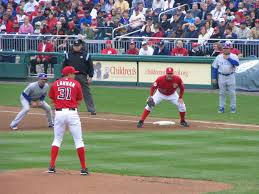
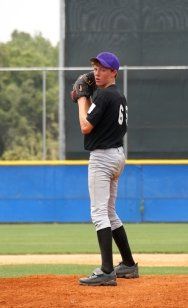
What makes the feet illegal in the set position is when the pivot foot is outside the pitching rubber – either to the left or to the right of the red line marking the edges of the rubber. You can see this in the illustrations below. Note that in the image on the right, the free foot is also outside the edge of the rubber, but that is not the problem. The position of the pivot foot, not the free foot, is what makes the position illegal.
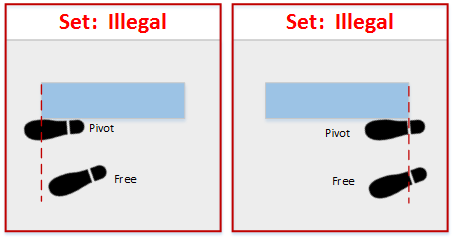
Figure 5. Illegal foot positions in the set
Pitching from the set position
First, let's repeat one very important point that we covered in our article, The Pitcher. When the pitcher has his pivot foot engaged (touching) the pitching rubber, he is, by rule, a pitcher; when his feet are not engaged to the rubber, he is simply another of nine fielders.
This is important, because the special rules for pitchers only apply while he is engaged to the rubber (when he is "technically" a pitcher). When the pitcher disengages, these restrictions no longer apply.
There are five stages to pitching from the set position. Let's assume for now that there are runners on base.
 Pre-engage. Young pitchers are taught to engage the rubber by first straddling it. In this position, because they have not yet engaged the rubber, they are technically still fielders so they can quick-throw to a base from this position without penalty. Here's typical foot positions during pre-engage.
Pre-engage. Young pitchers are taught to engage the rubber by first straddling it. In this position, because they have not yet engaged the rubber, they are technically still fielders so they can quick-throw to a base from this position without penalty. Here's typical foot positions during pre-engage.
- Engage the rubber ("toe the rubber"). Then the pitcher engages the rubber by moving his pivot foot to its proper position on or in front of (but touching) the rubber, and adjusting his free foot in front of it, as shown in the Figure 4. The player is now technically a pitcher, so he is limited in what he can do. He can continue with the pitching sequence, step and throw to a base, or he can disengage the rubber, becoming a fielder once again, and then start the sequence all over.
Important: Pitchers must have possession of the ball when they engage or straddle the rubber. If they don't, you have a balk. Pitchers are normally taught to keep the ball in their hand, but having it in the glove is allowed. If the ball is in their hand, it must be at their side or behind them, as you see in the photos below.
- Go into the stretch. The next step is taking signs from the catcher. From the set position, the pitcher typically takes signs by going into the stretch. That is, he moves his free foot forward and leans in toward home plate. However, this is not required. Some pitchers take their signs from the position they acquired when they toed the rubber. This is allowed. Here are two views of the stretch, one by a righty, the other a lefty. You can see there is quite a bit of variation from pitcher to pitcher.
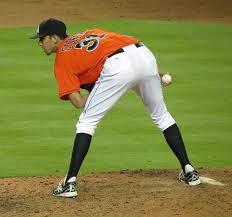
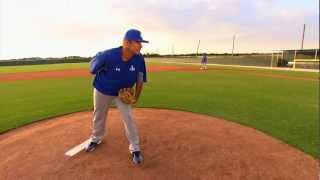
- Come set. After taking signs, the pitcher comes set by drawing himself upright and bringing his hands together with the ball. The pitcher in the photo below has come set with his hands at his chest. Some pitchers come set with their hands lower, near their belt, while others have their glove up in front of their face.
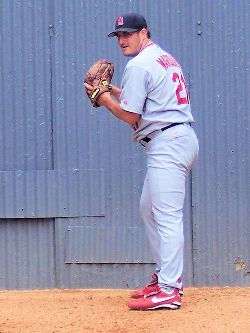
Once the pitcher comes set, a new set of restrictions apply:
- He can no longer turn to look at runners on base. He can turn his head but cannot turn his shoulders or body. If he does, it's a balk.
- He cannot change the position of his hands in the set, neither up nor down. Doing so is a "double-set" and it's a balk.
- Once he brings his hands together, he cannot separate them – except to complete one of the three actions we discuss in the next stage (deliver the pitch, step and throw to a base, or disengage the rubber). Separating the hands without completing one of these actions is a balk.
- He must come to a complete and discernible stop in the set position before delivering the pitch. The most common balk call for young pitchers is "blowing through the stop." Pitchers will bring their hands together and move continuously into their delivery without pausing. This is a balk.
- Finish the sequence in one of three ways:
- Deliver the pitch. Following the discernible pause, the pitcher may deliver the pitch to the batter.
- Step and throw to an occupied base. The pitcher may step and throw to an occupied base for the purpose of picking off a runner. However, in doing so he must meet certain requirements. He must step in the direction of the base, and his step must gain distance in that direction. The hallmarks of a legal step-and-throw is the lead foot gaining distance and direction. A jump step is also legal, but, again, the lead foot must gain some distance in the direction of the base to which the throw is made.
- Properly disengage the rubber. The pitcher may disengage the rubber, but must do so properly. He must step backward off the rubber with his pivot foot. Improperly disengaging the rubber is a balk. However, once he has disengaged the rubber, he is now a fielder, not a pitcher, and all of the restrictions placed on the pitcher are no longer in effect.
Here's a flow chart depicting the pitching sequence from the set position.
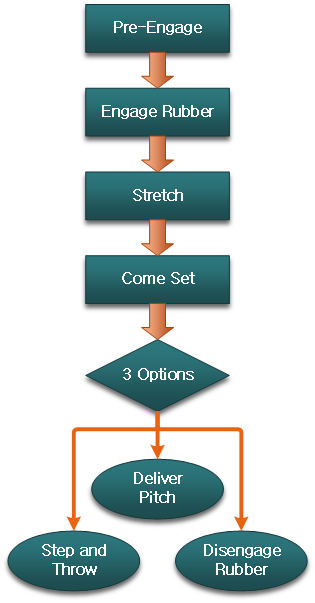
The Hybrid Position
In recent years, a so-called "hybrid" position has gained currency in some quarters. The position is controversial, however, because it does not, strictly speaking, meet the requirements for either the windup or the set position. Despite this, the hybrid position is being allowed in the major leagues and is being seen increasingly in NCAA games.
The high school federation (NFHS), however, is not allowing the hybrid position and in recent years has made it a point of emphasis to call a balk (with runners on base) or an illegal pitch when a pitch is delivered from the hybrid position.
Because the situation is fluid, we can't provide clear guidance on handling the hybrid setup. For guidance, discuss this with your association.
Here's a look at the hybrid setup. The issue is not with the free foot's position; rather, the problem is with the position of the pivot foot – it is engaged to the rubber, but is not entirely in contact with the rubber, nor is it parallel to the rubber.

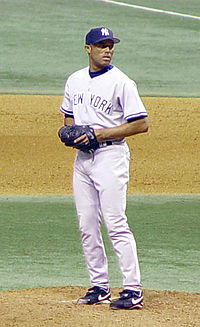
Here is a photo of former Yankees great, Mariano Rivera; he has engaged the rubber in the hybrid position. His feet do not meet the technical requirements for either the windup or the set position.

